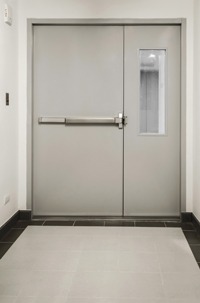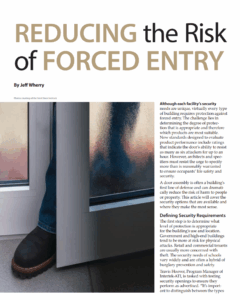Reducing the Risk of Forced Entry
In today’s world, security threats are a growing concern for both commercial and government facilities. Architects and building owners are increasingly looking for door systems that can help deter and delay forced entry. This article explores how steel doors and frames can play a vital role in securing a building’s perimeter. Learn how proper design, testing standards, and product selection can significantly reduce the risk of unauthorized access.
Although each facility’s security needs are unique, virtually every type of building requires protection against forced entry. The challenge lies in determining the degree of protection that is appropriate and therefore which products are most suitable. New standards designed to evaluate product performance include ratings that indicate the door’s ability to resist as many as six attackers for up to an hour. However, architects and specifiers must resist the urge to specify more than is reasonably warranted to ensure occupants’ life safety and security.
Defining Security Requirements

The first step is to determine what level of protection is appropriate for the building’s use and location. Government and high-end buildings tend to be more at risk for physical attacks. Retail and commercial tenants are usually more concerned with theft. The security needs of schools vary widely and are often a hybrid of burglary prevention and safety.
Travis Hoover, Program Manager of Intertek-ATI, is tasked with testing security openings to ensure they perform as advertised. “It’s important to distinguish between the types of threats because they are addressed quite differently. Physical attacks tend to be more planned and sophisticated. For those, we test a lot of bullet resistant doors with laminated glass that won’t shatter. Those doors usually have steel stiffeners and higher gauge steel.”
“For burglary prevention, the openings we test often have seamless welds, reinforced hardware, and steel stiffeners,” added Hoover.
Finding the “Just Right” Amount of Security
In the aftermath of any violent tragedy such as a terrorist attack or school shooting, people are left feeling vulnerable, having been robbed of their sense of security. As a result, it is not uncommon for there to be a reflexive push to implement the maximum degree of security on openings and facilities, well beyond what is necessary to protect the building’s occupants. Overspecification means unnecessary costs.
Ironically, deciding what degree of security is appropriate can become more difficult with lower levels of risk. Specifying a steel door rated with the highest levels of blast, ballistics, and forced entry resistance would be considered absolutely appropriate for high risk government facilities and potential terrorist targets such as dams or nuclear power plants. But what is appropriate for corporate offices or retail locations whose owners are generally more concerned with theft? How do the security needs of a warehouse differ from those of a jewelry store?
Design professionals should consider:
- The budget;
- the risk of physical attack, burglary, or both;
- the severity of the risk;
- if bullet resistant doors would make sense;
- (for existing buildings) if retrofitting the windows and steel doors would be sufficient.
Addressing the items above should never come at the expense of life safety. Barricades and security gadgets often do not meet the most essential life safety concepts such as the ability to egress in one operation without any special knowledge or effort. Stick to tested and approved products that won’t have the local Fire Marshal steaming.
Specifying Forced Entry Resistance

Rather than get bogged down with components or door construction, the standards below can be specified to ensure the desired level of safety.
-
ASTM F1233 Standard Test Method for Security Glazing Materials and Systems
This is the most commonly specified test criteria for non-government forced entry installations. Products are assigned a resistance rating using Roman numerals I through V. The test for a Class I rating consists of the product being hit with a ballpein hammer 10 times. Class II is another 10 impacts. To achieve a Class V designation, entries must withstand 41 assaults including 50 impacts with a fire axe.
-
ASTM F3038 Standard Test Method for Timed Evaluation of Forced-Entry-Resistant Systems
Typically specified for high risk buildings, this test method allows one to specify forced entry prevention of 5, 15, 30, or 60 minutes. The test is comprised of six men attacking the door with everything from sledgehammers to battering rams. If the attackers breach the door, the product fails.
-
US Department of State SD-STD-01.01 Forced Entry and Ballistic Resistance of Structural Systems
This test is similar to ASTM F3038 but is specific to government facilities.
Perhaps ASTM F1233 Class II should be specified for a high-end retailer to withstand 20 whacks of a hammer? Specifying 30 minutes of protection in accordance to ASTM F3038 for a water treatment plant could thwart a potential terrorist. Door assemblies that can withstand 60 minutes of SD-STD-01.01 and are bullet and blast resistant could make all the difference in the world to a distant US embassy under attack.
These are just examples. Consider working with a security consultant for guidance on a specific project.
“Bulletproof” Doors
Ballistics go hand-in-hand with forced entry. While the most common standard for evaluating the efficacy of a bullet-resistant core, UL 752 Standard for Bullet-Resisting Equipment, has numerous levels of resistance, none are considered “bullet-proof.” That phrase gets thrown around a lot, but until the technology for force fields moves beyond the realm of science fiction and it becomes possible to repel bullets, no door is “bulletproof,” only bullet-resistant.
Bullet-resistant doors are frequently specified in government buildings, cashier stands, high crime areas and any structure where increased safety is desired. They are typically constructed using formed, heavy gauge steel face sheets around a custom engineered steel rib core. They are manufactured at eight different levels, which indicate the number of shots from a particular caliber of bullet that a door can resist. For example, a level 1 door can stop three shots from a 9 mm; a level 8 can withstand five shots from a .308 caliber rifle.
Although end users could easily be convinced that “more is better,” a level 2 or 3 door offers plenty of protection for most applications. A level 8 door will cost substantially more than a level 1 bullet-resistant steel door, so be sure to specify the appropriate level of resistance.
Hey Good Lookin’
After making hundreds of thousands of secure door assemblies, SDI member manufacturers often hear, “But this looks just like a regular door!” It’s as if they were expecting imposing steel bars and bulky hardware.
Architects and specifiers should let their customers know beforehand that security doors look just like the rest. That way when they see the door they’ll know it’s the performance that counts.

